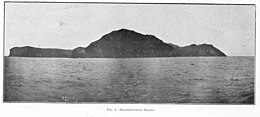
Summary
Disappointment Island is one of seven uninhabited islands in the Auckland Islands archipelago, in New Zealand. It is 475 kilometres (295 mi) south of the country's main South Island and 8 kilometres (5 mi) from the northwest end of Auckland Island. It is home to a large colony of white-capped albatrosses: about 65,000 pairs – nearly the entire world's population – nest there.[1] Also on the island is the Auckland rail, endemic to the archipelago; once thought to be extinct, it was rediscovered in 1966.[2]
 A photo taken of the island in 1909. | |
 Position of the Auckland Islands relative to New Zealand and other outlying islands | |
| Geography | |
|---|---|
| Coordinates | 50°36.25′S 165°58.38′E / 50.60417°S 165.97300°E |
| Archipelago | Auckland Islands |
| Area | 3.0 km2 (1.2 sq mi) |
| Length | 3.35 km (2.082 mi) |
| Width | 1.53 km (0.951 mi) |
| Demographics | |
| Pop. density | 0/km2 (0/sq mi) |
History edit
On 7 March 1907, the Dundonald, a steel, four-masted barque, sank after running ashore on the west side of Disappointment Island. Twelve men drowned and seventeen men made it ashore.[3] Two of the men died, and fifteen survivors waited seven months for rescue.[4] They survived by eating mainly white-capped albatrosses (mollymawks), seals, and roots of the plant Azorella polaris, and, later, supplies at the castaway depot on Auckland Island.[3] The island was visited by a scientific expedition aboard the Hinemoa in November 1907, after the crew rescued the Dundonald survivors from Auckland Island.[5][3]
Etymology edit
British mariner Abraham Bristow, who was the first European to reach the Auckland Islands, named the island Disappointment Island.[6][7] Whilst aboard the ship Sarah in 1807, he unsuccessfully surveyed the island for fur seals and a base to reach the nearby fur seal rookeries on the western cliffs of Auckland Island.[6][7]
Important Bird Area edit
The island is part of the Auckland Island group Important Bird Area (IBA), identified as such by BirdLife International because of the significance of the group as a breeding site for several species of seabirds, including the white-capped mollymawk and white-chinned petrel, as well as the endemic Auckland shag, Auckland teal, Auckland rail, and Auckland snipe.[8][9]
See also edit
References edit
- ^ BBC – Science and Nature Archived 5 December 2004 at the Wayback Machine.
- ^ Auckland Islands Rail.
- ^ a b c Escott-Inman, Herbert (1911). The Castaways of Disappointment Island. S.W. Partridge & Co.
- ^ Wrecked on the Auckland Islands in 1907.
- ^ Cockayne, L. (3 December 1907), "Disappointment Island. A new field. The first scientific visitors. Animals and plants on the island.", The Lyttelton Times, retrieved 20 August 2020
- ^ a b Walker, Kath; Elliott, Graeme; Rexer-Huber, Kalinka; Parker, Graham; Sagar, Paul; McClelland, Peter J. (2020). "Shipwrecks and mollymawks: an account of Disappointment Island birds". Notornis. 67 (1): 213–245.
- ^ a b Jones, K. K.; Dingwall, P. R. (1 January 2009). "Historic landscapes and seascapes of the Auckland Islands". New Zealand Archaeological Association Monograph. 27: 245–267.
- ^ BirdLife International. (2012). Important Bird Areas factsheet: Auckland Islands. Downloaded from "BirdLife International - conserving the world's birds". Archived from the original on 10 July 2007. Retrieved 16 December 2012. on 2012-01-23.
- ^ Walker, Kath; Elliott, Graeme; Rexer-Huber, Kalinka; Parker, Graham; Sagar, Paul; McClelland, Peter J. (1 January 2020). "Shipwrecks and mollymawks: an account of Disappointment Island birds". Notornis. 67 (1): 213–245.


